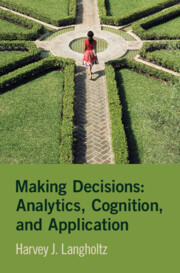
- Coming soon
- Publisher:
- Cambridge University Press
- Expected online publication date:
- October 2025
- Print publication year:
- 2025
- Online ISBN:
- 9781009450850
- Subjects:
- Strategic Management, Psychology, Cognition, Management

In today's data-driven world, this book offers clear, accessible guidance on the logical foundations of optimal decision making. It introduces essential tools for decision analysis and explores psychological theories that explain how people make decisions in both professional and personal contexts. Using real-world examples, the book covers topics such as decision making under uncertainty, decision trees, strategies of risk management, decisions that are gambles, heuristics, trade-offs, decision making under stress, game theory, decision making in a dispute or conflict, and multi-attribute decision analysis. Readers will identify common decision traps and learn how to avoid them, understand the causes of indecisiveness and find out how to deal with it, gain insights into their own decision-making processes, and build confidence in their ability to make and defend informed decisions across a range of scenarios.
‘In life, we make many decisions every day. Little ones like what dessert to order and big ones like who to marry. How do we do it? In this highly readable book, Harvey Langholtz provides a comprehensive review of what we know about how people make decisions. When do they take risks and when do they play it safe? Readers will learn what science reveals, and perhaps even get better at managing the gambles that life throws our way.'
Elizabeth F. Loftus - Distinguished Professor, University of California, Irvine, and Past President of Association of Psychological Science
‘In Making Decisions: Analytics, Cognition, and Application, psychologist Harvey Langholtz has done a masterful job of uniting various theories of decision making with a vast body of empirical research on how people actually decide. He covers topics that are almost never brought together in a single book, and explains theories with great clarity and plentiful well-drawn and well-written examples. I taught decision making to undergraduates for 25 years, and were I to teach again, I would use this book in a heartbeat. It sets the standard for what one can aspire to in covering this very important field, whether at the undergraduate or graduate level.'
Barry Schwartz - author of The Paradox of Choice and Visiting Professor at the Haas School of Business, University of California, Berkeley
 Loading metrics...
Loading metrics...
* Views captured on Cambridge Core between #date#. This data will be updated every 24 hours.
Usage data cannot currently be displayed.
The PDF of this book conforms to version 2.0 of the Web Content Accessibility Guidelines (WCAG), ensuring core accessibility principles are addressed and meets the basic (A) level of WCAG compliance, addressing essential accessibility barriers.
Allows you to navigate directly to chapters, sections, or non‐text items through a linked table of contents, reducing the need for extensive scrolling.
Provides an interactive index, letting you go straight to where a term or subject appears in the text without manual searching.
You will encounter all content (including footnotes, captions, etc.) in a clear, sequential flow, making it easier to follow with assistive tools like screen readers.
You get concise descriptions (for images, charts, or media clips), ensuring you do not miss crucial information when visual or audio elements are not accessible.
You get more than just short alt text: you have comprehensive text equivalents, transcripts, captions, or audio descriptions for substantial non‐text content, which is especially helpful for complex visuals or multimedia.
You will still understand key ideas or prompts without relying solely on colour, which is especially helpful if you have colour vision deficiencies.
You gain clarity from ARIA (Accessible Rich Internet Applications) roles and attributes, as they help assistive technologies interpret how each part of the content functions.